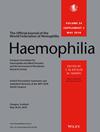Clinical, Phenotypic and Genotypic Characteristics of Von Willebrand Disease in Afro-Caribbeans: Results From a Study in Martinique Island, French West Indies
Abstract
Background
Several cohort studies have investigated the molecular basis of von Willebrand disease (VWD); very few have focused on the Afro-Caribbean population.
Objectives
To determine the genotypic and phenotypic characterization of VWD in a large cohort of Afro-Caribbean patients living in Martinique.
Materials and Methods
A total of 31 families comprising 63 Afro-Caribbean patients with VWD were enrolled. A standardized questionnaire and blood samples were collected for biological and molecular genetic analyses of von Willebrand factor (VWF). The impact of new missense variants has been predicted by in silico studies.
Results
The median age of patients was 53 years (range 9–99). The most frequent symptoms were menorrhagia (49%), easy bruising (44%) and prolonged bleeding after tooth extraction (42%). Fifteen patients (24%) had quantitative deficiencies of VWF, of whom 13 (21%) were assigned as VWD-type 1, 1 (1%) as VWD-type 1C and 1 (2%) as VWD-type 3. Forty-five patients were diagnosed with VWD-type 2 (qualitative defects of VWF) (71%). VWD-type 2A was the most frequent, with 36 patients. Seven patients had VWD-type 2M and two patients had VWD-type 2B. Three patients (5%) had an indeterminate effect of the VWF defect due to ISTH BAT at 0. Forty-eight different VWF variants, including 4 novel variants, were identified in 63 patients. The variants consisted of 34 (71%) missense, 7 (15%) synonymous, 3 (6%) frameshifts, 2 (4%) small deletions and 2 (4%) gene conversions.
Conclusions
This study emphasizes the unique distribution of genotypes in our cohort of Afro-Caribbean VWD patients living in Martinique.
Essentials
- Genotype-phenotype correlation was assessed in VWD Afro-Caribbean patients with one or more VWF variants.
- Menorrhagia, easy bruising and prolonged bleeding after tooth extraction are common in VWD patients.
- Efforts to increase the awareness and diagnosis of VWD have contributed to a better identification of patients with bleeding disorders.


 求助内容:
求助内容: 应助结果提醒方式:
应助结果提醒方式:


